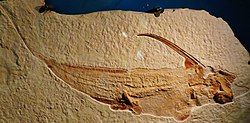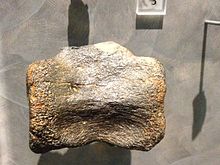Tar Heel/Coachman Formation
From Wikipedia, the free encyclopedia
The Tar Heel Formation, also known as the Coachman Formation in South Carolina, is a Late Cretaceous (early to middle Campanian-aged) geologic formation in North Carolina and South Carolina, USA. It preserves fossils, including amber dating back to the Cretaceous period. A locality known as Phoebus Landing, has been dated to 78.5-77.1 Ma, and the formation has been overall dated to the early Campanian based on fossil pollen.[1][2][3]
| Tar Heel/Coachman Formation | |
|---|---|
| Stratigraphic range: Early-Middle Campanian ~ | |
| Type | Formation |
| Unit of | Black Creek Group |
| Underlies | Bladen Formation |
| Overlies | Middendorf Formation |
| Lithology | |
| Primary | Siltstone, sandstone |
| Location | |
| Coordinates | 34.6°N 78.5°W |
| Approximate paleocoordinates | 35.0°N 50.2°W |
| Region | North Carolina South Carolina |
| Country | United States |
| Type section | |
| Named for | Tar Heel, North Carolina |
Likely deposited in a nearshore coastal environment representing a lower shoreface, it contains a high diversity of vertebrate remains. It has one of the most diverse dinosaur faunas known from the former landmass of Appalachia, the majority of which are known from two sites: Phoebus Landing along the Cape Fear River in Bladen County, North Carolina, as well as Stokes Quarry in Darlington County, South Carolina.[4][5][6]
Fossil pollen grains suggest a subtropical to warm, moist temperate climate for the region, with an ecosystem largely dominated by flowering plants.[3] The Tar Heel/Coachman Formation appears to be roughly concurrent with the Marshalltown Formation of New Jersey, which preserves a similar fauna.[4]
Paleobiota
Summarize
Perspective
Cartilaginous fish
Based on the Paleobiology Database & Robb (1989):[7][8]
| Cartilaginous fish of the Tar Heel/Coachman Formation | ||||||
|---|---|---|---|---|---|---|
| Genus | Species | Location | Notes | Images | ||
| "Asteracanthus" | A. sp. | Phoebus Landing, NC | A hybodontid shark. | |||
| Brachyrhizodus | B. wichitaensis | Phoebus Landing, NC | An eagle ray. |  | ||
| Carcharias | C. holmdelensis | Phoebus Landing, NC | A sand shark. |  | ||
| C. samhammeri | ||||||
| "Hypolophus" | H. sp. | Phoebus Landing, NC | A whiptail stingray. | |||
| Meristodonoides | M. montanensis | Phoebus Landing, NC | A hybodontid shark. |  | ||
| Rhombodus | R. laevis | Phoebus Landing, NC | A rhombodontid ray. |  | ||
| I. mira | Phoebus Landing, NC | A sawskate. |  | |||
| Ischyodus | I. cf. bifurcatus | Phoebus Landing, NC | A callorhinchid chimaera. |  | ||
| Scapanorhynchus | S. texanus | Phoebus Landing, NC | A goblin shark. |  | ||
| S. kaupi | Phoebus Landing, NC
Stokes Quarry, SC |
An anacorid shark. Includes a coprolite potentially assignable to S. kaupi, containing the vertebrae of a baby turtle.[9] |  | |||
| S. pristodontus | ||||||
| Squatina | S. hassei | Phoebus Landing, NC | An angelshark. |  | ||
Ray-finned fish
Based on the Paleobiology Database, Robb (1989) & Stringer et al (2018). Some species are known only from otolith remains from Blue Banks & Auger Hole Landings, North Carolina, which are indicated:[7][8][10]
| Genus | Species | Location | Material | Notes | Images |
|---|---|---|---|---|---|
| Albula | ?A. campaniana | Blue Banks & Auger Hole Landings, NC | 263-378 otoliths | A bonefish. |  |
| ?A. cf. A. ripleyensis | Blue Banks Landing, NC | 1 otolith | |||
| A. sp. | Phoebus Landing, NC | ||||
| Anomoeodus | A. phaseolus | Phoebus Landing, NC | A pycnodontid pycnodont. |  | |
| Ariidae indet. | Blue Banks Landing, NC | 11 otoliths | A sea catfish of uncertain affinities. | ||
| Aulopidae indet. | Blue Banks Landing, NC | 1 otolith | A flagfin of uncertain affinities. | ||
| Beryx | ?B. maastrichtiensis | Blue Banks & Auger Hole Landings, NC | 55 otoliths | A potential relative of alfonsinos. |  |
| ?B. zideki | 41 otoliths | ||||
| ?Congridae indet. | Auger Hole Landing, NC | 1 otolith | An apparent conger eel of uncertain affinities. | ||
| Cylindracanthus | C. ornatus | Phoebus Landing, NC | A fish of uncertain affinities. |  | |
| Enchodus | E. cf. petrosus | Phoebus Landing, NC | An enchodontid aulopiform. |  | |
| Gonostomatidae indet. | Blue Banks & Auger Hole Landings, NC | 4 otoliths | A bristlemouth of uncertain affinities. | ||
| Hoplostethus | ?H. coffeesandensis | Blue Banks & Auger Hole Landings, NC | 4 otoliths | A slimehead. |  |
| Kokenichthys | K. ensis | Blue Banks Landing, NC | 2 otoliths | An elopiform or osteoglossiform.[11] | |
| Lepisosteidae indet. | Phoebus Landing, NC | A gar. | |||
| Megalopidae indet. | Blue Banks Landing, NC | 1 otolith | A tarpon of uncertain affinities. | ||
| Osmeroides | O. weileri | Blue Banks Landing, NC | 6 otoliths | An osmeroidid elopomorph. |  |
| Paralbula | P. casei | Phoebus Landing, NC | A phyllodontid elopomorph. | ||
| ?Pempheris | ?P. huddlestoni | Auger Hole Landing, NC | 1 otolith | An apparent sweeper. |  |
| Percoidei indet. | Blue Banks & Auger Hole Landings, NC | 5 otoliths | A percoid. | ||
| ?Polymixia | ?P. cf. harderi | Blue Banks Landing, NC | An apparent beardfish. |  | |
| Pterothrissus | P. carolinensis | Blue Banks Landing, NC | 67 otoliths | A pterothrissine bonefish. |  |
| Saurodon | S. sp. | Phoebus Landing, NC | A saurodontid ichthyodectiform. |  | |
| Stephanodus | S. sp. | Phoebus Landing, NC | A pycnodont. | ||
| Xiphactinus | X. audax | Phoebus Landing, North Carolina, NC | An ichthyodectid ichthyodectiform. |  | |
| X. vetus |
Reptiles
Records from SC based on Schwimmer et al (2015):[6]
Dinosaurs
Ornithischians
Based mainly on Brownstein (2018):[4]
| Ornithischians of the Tar Heel/Coachman Formation | ||||||
|---|---|---|---|---|---|---|
| Genus | Species | Location | Notes | Images | ||
|
cf. Hadrosaurus |
?H. foulkii | Phoebus Landing & Sampson County, NC[12] | A hadrosaurid, tentatively assigned to the well-known H. foulkii. |  | ||
| "Hadrosaurus" | "H." minor | Phoebus Landing, NC | A small or juvenile hadrosaur, nomen dubium. | |||
| H. crassicauda | Phoebus Landing & Sampson County, NC | A gigantic hadrosauroid. First discovered in North Carolina from Sampson County, 1869, and described by Edward Drinker Cope. It was measured to be 12-17 meters, making it one of the largest hadrosauroids.[13] Type locality for genus and species. |  | |||
| Leptoceratopsidae indet. | Sampson County, NC | A leptoceratopsid ceratopsian. Known from an indeterminate left maxilla found in 2016.[14] | ||||
| L. atopus | Phoebus Landing, NC | A hadrosauromorph. Originally described from the Mooreville Chalk Formation, Alabama. |  | |||
An indeterminate hadrosauroid is known from Stokes Quarry, SC.[4]
Theropods
| Theropods of the Tar Heel/Coachman Formation | ||||
|---|---|---|---|---|
| Genus | Species | Location | Notes | Images |
| Appalachiosaurus | A. montgomeriensis | Stokes Quarry, SC | A large eutyrannosaur.[4] |  |
| cf. Coelosaurus (="Ornithomimus") | C. sp. | Phoebus Landing, NC | An intermediate ornithomimosaur.[4][15] |  |
| Dromaeosauridae indet. | Sampson County, NC | A large dromaeosaurid, larger than Saurornitholestes but smaller than Dakotaraptor.[16] | ||
| Dryptosaurus | D. sp. | Phoebus Landing, NC | A large dryptosaurid eutyrannosaur. Originally known from the Maastrichtian of New Jersey, but similar remains referable to this species have been recovered from the Tar Heel.[4] However, most of the attributed specimens are considered as indeterminate Eutyrannosauria separate from this genus, with only a partial femur fragment tentatively classified as D. sp.[17] |  |
| S. langstoni | Burches Ferry & Stokes Quarry, SC |
A widespread dromaeosaurid ("raptor"). Specimens from this formation provided the first evidence of this species from Appalachia.[4][18][19] |
 | |
Indeterminate theropods, ornithomimosaurs, and maniraptorans are known from Stokes Quarry.[4]
Crocodylomorphs
Based on the Paleobiology Database:[7]
| Genus | Species | Location | Notes | Images |
|---|---|---|---|---|
| Borealosuchus | B. formidabilis | Phoebus Landing, NC | A eusuchian. |  |
| Bottosaurus | B. sp. | Stokes Quarry, SC | An early caiman. | |
| Deinosuchus | D. rugosus (=Thecachampsa rugosa, Polydectes biturgidus, Polyptychodon rugosus) | Phoebus Landing & Clifton Farm, NC
Stokes Quarry, SC |
An alligatoroid, one of the largest known crocodilians. Type locality for genus and species. |  |
| Gavialoidea indet. | Stokes Quarry, SC | A gavialoid. |
Turtles
Based on the Paleobiology Database:[7]
| Genus | Species | Location | Notes | Images |
|---|---|---|---|---|
| Adocus | A. beatus | Phoebus Landing, NC
Stokes Quarry, SC |
An adocid. |  |
| Bothremys | B. cooki | Phoebus Landing, NC | A bothremydid side-necked turtle. | |
| Chedighaii | C. barberi | Phoebus Landing, NC | A bothremydid side-necked turtle. | |
| C. hutchinsoni | ||||
| Corsochelys | C. bentlyi | Stokes Quarry, SC | A sea turtle, likely a dermochelyid. Type locality for species. | |
| Euclastes | E. wielandi | Stokes Quarry, SC | A pancheloniid sea turtle. |  |
| Osteopygis | O. emarginatus | Phoebus Landing, NC | A macrobaenid. |  |
| ?Taphrosphys | ?T. dares | Phoebus Landing, NC | A bothremydid side-necked turtle, taxonomic placement disputed. | |
| Toxochelys | T. sp. | Stokes Quarry, SC | A toxochelyid sea turtle. |  |
| "Trionyx" | "T." halophilus | Phoebus Landing, NC | A stem-softshell turtle, likely not an actual member of the genus Trionyx. Species names are nomina dubia. | |
| "T." priscus | Stokes Quarry, SC |
Plesiosaurs
| Genus | Species | Location | Notes | Images |
|---|---|---|---|---|
| Elasmosauridae indet. | Stokes Quarry, South Carolina | An elasmosaurid. |
Squamates
| Genus | Species | Location | Notes | Images |
|---|---|---|---|---|
| Halisaurus | H. sp. | Phoebus Landing, NC | A halisaurine mosasaur. |  |
| Platecarpus | P. sp. | Phoebus Landing, NC | A plioplatecarpine mosasaur. |  |
| Prognathodon | P. sp. | Phoebus Landing, NC | A mosasaurine mosasaur. |  |
| Teiidae indet. | Stokes Quarry, SC | A teiid lizard. | ||
| Tylosaurus | T. sp. | Phoebus Landing, NC
Stokes Quarry, SC |
A tylosaurine mosasaur. |  |
Mammals
Based on the Paleobiology Database:[20]
| Genus | Species | Location | Notes | Images |
|---|---|---|---|---|
| Marsupialia indet. | Darlington County, SC | A presumed marsupial relative.[20] | ||
| Multituberculata indet. | Darlington County, SC | A multituberculate.[20] |
References
Wikiwand - on
Seamless Wikipedia browsing. On steroids.